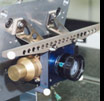For image reconstruction on the ground (no impact on real-time
spacecraft operations), knowledge of relative roll is required at all
times to 3 arcmin (3 sigma). Since all sources of torque on the
spacecraft are weak, the required information can be obtained with
a star scanner that samples the roll orientation at least once per
rotation. Interpolation between measurements allows the roll
orientation to be determined at intermediate times with the required
accuracy. Data from the RAS are acquired and processed for transfer to the image data processing unit (IDPU) and inclusion in the telemetry stream in a dedicated aspect data processor (ADP).
 The RAS consists of a 2048-element
linear photodiode array and electronics (nearly identical to those of the SAS) behind an f/1.0, 50-mm lens. A sunshade limits the FOV so that a 30°
band is swept out across the sky orthogonal to the spin axis. As the spacecraft
rotates, each detected star generates a brief spike in the output of one
or two pixels, whose timing defines the roll orientation. For +2 magnitude
stars, the detection signal-to-noise is 15:1. Allowing for Earth occultation
and the recovery time from anticipated Earthshine saturation, at least
one (and typically seven) such star(s) will be detected each rotation throughout
the mission. Measurements of only one star, averaged over a minute, allow
the roll angle to be determined to 2.7 arcmin (3 sigma). The RAS was built by the Paul Scherrer Institute in Switzerland. The RAS consists of a 2048-element
linear photodiode array and electronics (nearly identical to those of the SAS) behind an f/1.0, 50-mm lens. A sunshade limits the FOV so that a 30°
band is swept out across the sky orthogonal to the spin axis. As the spacecraft
rotates, each detected star generates a brief spike in the output of one
or two pixels, whose timing defines the roll orientation. For +2 magnitude
stars, the detection signal-to-noise is 15:1. Allowing for Earth occultation
and the recovery time from anticipated Earthshine saturation, at least
one (and typically seven) such star(s) will be detected each rotation throughout
the mission. Measurements of only one star, averaged over a minute, allow
the roll angle to be determined to 2.7 arcmin (3 sigma). The RAS was built by the Paul Scherrer Institute in Switzerland.
|